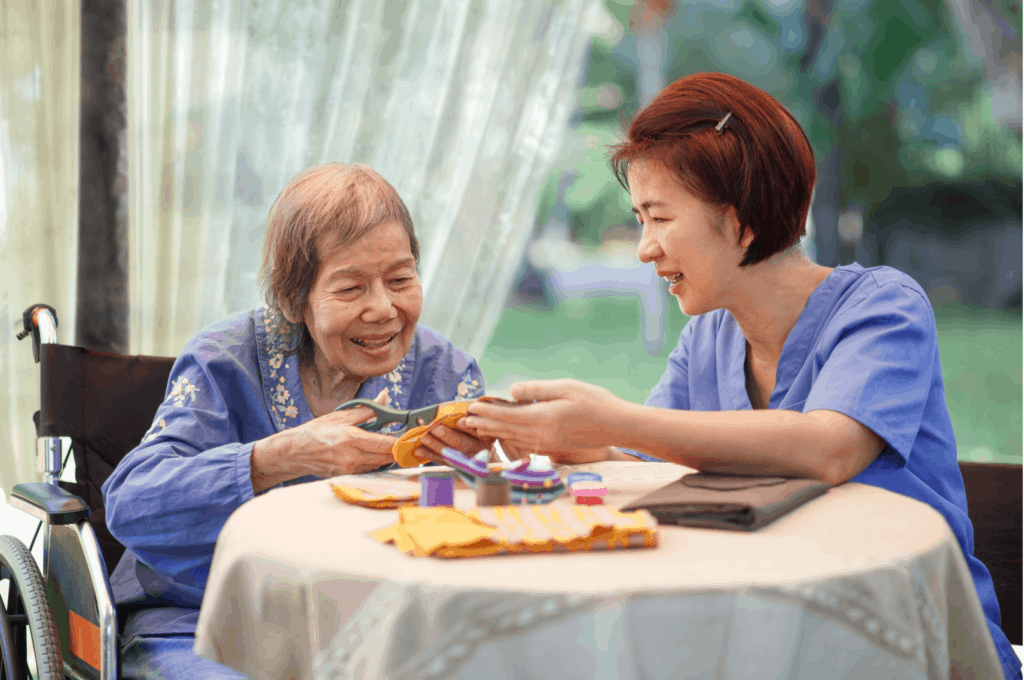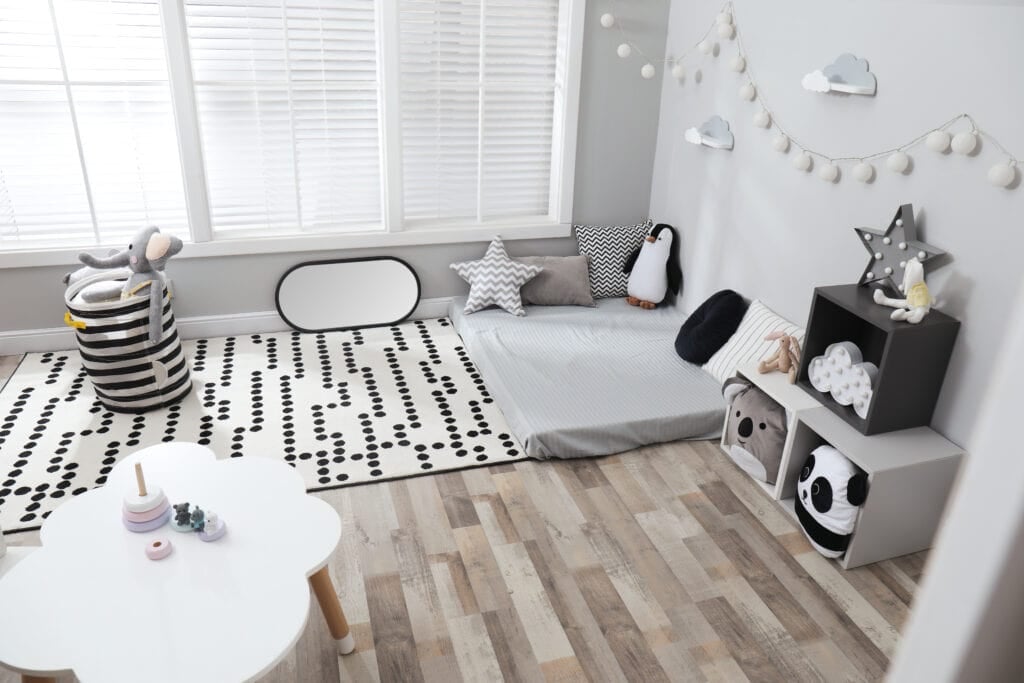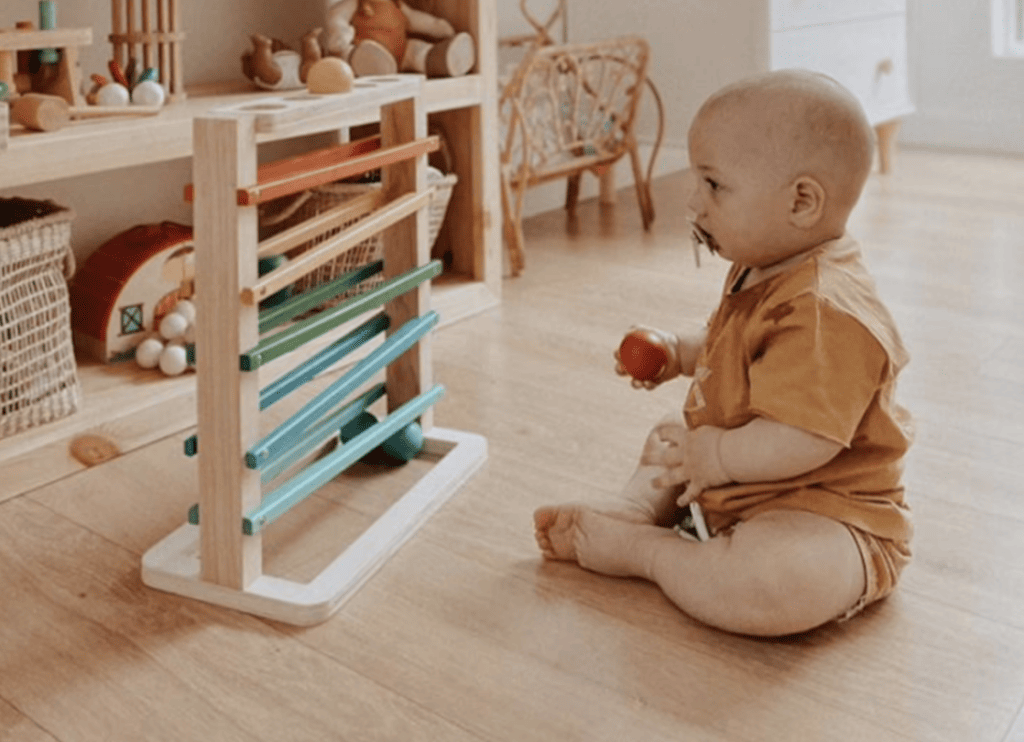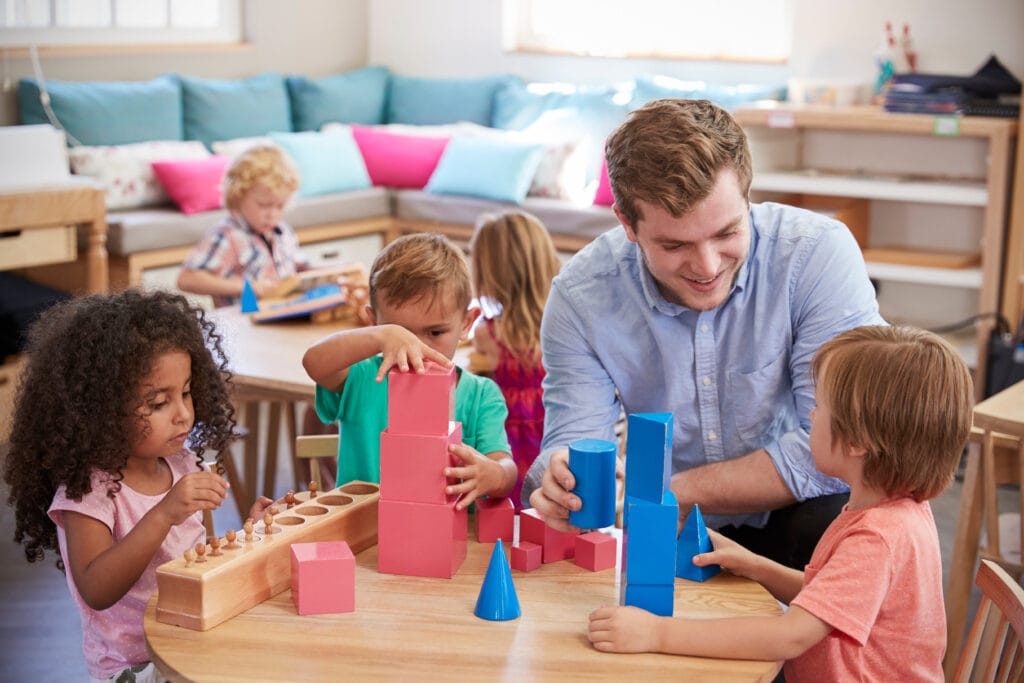Though the
But
All of the activities listed below can be completed individually or in a group setting for additional socialization. Additionally, they all can be modified to meet each person’s abilities or needs. Keep in mind that supervision is often necessary for individuals with dementia, though the degree of supervision may vary depending on the activity and individual.
See also: How and Why Montessori can Help with Dementia

Encourage Artistic Expression
Art allows people to express themselves freely, without fear of critique or judgement. Any type of art that allows for experimentation and color mixing or layering will work for this activity. Acrylic paints with large handle paint brushes, oversized soft oil pastels, and jumbo beeswax crayons are three art mediums that are particularly useful, and have the added advantage of being non-toxic and easy to clean up.
Play and Learn Musical Instruments
Similar to art, music is a way for people to manifest their emotions and simply have fun. Instruments that are easy to grasp and play provide an outlet that stimulates without causing frustration.
Tambourines, drums, recorders and flutes, and guitars and ukuleles are four examples of instruments that anyone can play, regardless of prior experience or issues with hand-eye coordination or involuntary movement.
Practice Interactive Math Lessons
Interactive practice tools like the abacus board and multiplication tables allow people to physically engage with math equations and solve problems visually as well as mentally.
For easier versions of this activity, people can practice simple counting or sorting with common household items, such as cans of food or socks. All activities regardless of complexity develop problem solving and quantitative reasoning skills.
Try Different Science Experiments
For more advanced stimulation and to engage higher critical thinking, try science experiments. You can either buy a science kit or create one at home with common household goods. Science experiments are easily modifiable to fit each person’s needs and abilities, both in terms of materials and difficulty. They engage the senses as well as critical thinking, as well as simply being fun and educational to use.
Consider Excavation and Mining Kits
A more structured alternative to science experiments, fossil excavation and crystal mining kits involve repetitive motions and practicing muscle movement. The tools are easily modified and are available in a variety of difficulty levels.
This activity is rewarding without being overly strenuous or reliant on fine motor skills. If the individual has a specific interest in archeology or gemology, this activity can be particularly interesting.
Interact with Animals
For people that enjoy animals, interacting with them and providing care can be especially rewarding and is easily modifiable for each individual. Activities may include painting or assembling birdhouses, reading to or walking therapy dogs, brushing a cat, or even feeding farm animals. Trips to zoos and aquariums may also be beneficial, provided they are not stimulating to the point of distress.

Buy a Peg Board Set
To practice fine motor skills in a relaxed environment, peg boards with oversized pegs are useful. The large pegs allow for easy handling while the activity itself is single-minded. People can focus on the task in hand without being distracted by additional stimulation.
Though not particularly engaging for a long period of time, they are a reliable practice tool. To increase the difficulty, people can also arrange the pegs in specific patterns or shapes.
Cook or Bake in the Kitchen
This is an activity that engages all of the senses, is easily modifiable for each person, and creates a physical accomplishment. In a safe environment and with the proper supervision, people can create a variety of delicious foods.
Cookies, cake balls, and pizza are three examples of food that can vary in difficulty but are all relatively simple to make. This activity may require additional supervision due to the potential use of kitchen appliances like the oven or stove.

Go Classic with a Building Set
These sets come with interlocking pieces that are oversized for easy handling and assembly. People can free build with blocks, tubes and wheels to create structures. The nature of such sets allow people to recreate buildings they’ve seen in the past or craft fanciful, imaginary places. But keep in mind that these may be hard to use for people with hand-eye coordination issues. This activity is also useful for reconnecting people with younger children or grandchildren.
Make Your Own Candles
This is another activity that engages the senses and provides a tangible object for people with dementia to enjoy later on. Though it may require more extensive supervision due to the wax, candle making is an interactive and creative activity that everyone can enjoy.
People can create a variety of shapes, layer colors, inject different scents, choose from various wicks, and even customize their candle holder.
Create with Pre-Formed Stamps
Stamps can be used for brief entertainment or more lengthy activities such as scrapbooking. For the former, pre-formed stamps can be used to create shapes in moldable dough or on paper. If the latter is preferred, people can use stamps to create birthday cards, scrapbook pages, and even clothing designs. And for an extra activity and added stimulation, people can even help create the stamps themselves.
Put Puzzles Back Together
From jumbo ten-piece pictures to intricate creations that involve hundreds (or even thousands) of pieces, puzzles come in a variety of difficulty levels and can provide hours of engagement.
Once complete, they can either be preserved or mixed up again. Both options provide future enjoyment and place control in the hands of the person with dementia. There are also three-dimensional or virtual puzzles available to exercise spatial reasoning.
Craft Flower Arrangements
While also useful for sensory stimulation, flower arranging uses repetitive motions to strengthen muscles and improve hand-eye coordination. People can complete this activity whether standing or sitting and a variety of containers for the flowers can be used depending on individual needs. And after the activity is complete, people will have a tangible and pleasant reminder of their accomplishment.
Do Simple Household Chores
Though sometimes boring, household chores can help ground dementia patients and have the important benefit of making them feel useful. Folding towels, rinsing spoons, matching socks, and wiping down the table are all activities that they have likely done in the past. Such chores build on their current and past memories while strengthening motor skills.
These activities can also be completed in tandem with family members for an increased sense of connection.
Remember to Have Fun on the Holidays
Including people with dementia in holiday activities reasserts that they are still part of society and gently reminds them what time of year it is. Picking out pumpkins, crafting Valentine’s cards, brainstorming Christmas presents, and coloring Easter eggs are activities that everyone can participate in, no matter what type of dementia they have.
Though the person may believe they are in a past year, they are still able to connect to people in the present through these traditional activities.
A Brief History of the Montessori Method
According to the American Montessori Society® (AMS), the
Maria
From its original Italian roots, the
The Association Montessori Internationale (AMI) describes the current
There is no greater testament to this than its adaptation for people with dementia.
Elements of Montessori Activities
In order to be classified as a Montessori activity, there are several characteristics that the activity must encourage or utilize. These characteristics fall in line with the environment and culture the
- Promotes self-sufficiency and independence
- Develops critical thinking and fine motor skills
- Easily modified to individual needs or preferences
- Rooted in creativity and freedom of choice
- Explores and engages either one, some, or all senses
- Includes physical, hands-on components
- Encourages periods of concentration and focus
- Challenges without causing frustration
- Fosters pride and creates a palpable accomplishment
Each of these elements is important in its own right, but also in how it interacts with the other elements to create a holistic experience. If an activity promotes just one of the elements above and not the others, it lacks the full benefits of the
All of the activities listed in this article utilize the above characteristics in order to fully engage people affected by dementia.
Elements of a Montessori Environment
According to AMI, Montessori environments are marked by four main characteristics:
- Organized to support the developmental characteristics and interests of a mixed age group within an identified range
- Promotes lively and purposeful engagement in both indoor and outdoor settings
- Adaptable to any culture or setting
- Thrives through the trained adult’s careful observation of both universal and individual needs as revealed by the unique learner
Though these characteristics are geared toward child-centered learning and spaces, they remain true for both young and elderly individuals, especially the age groups most affected by dementia.
To prove this adaptability, we’ve modified two of the environmental elements below to specifically address those affected by dementia:
- Organized to support the developmental characteristics and interests of any age group
- Adaptable to any culture, setting, and age
The traditional
Types of Dementia and Common Symptoms
Dementia is a general term used in reference to a number of conditions that physically affect and alter the brain, causing memory loss and other symptoms.
There are actually several different types of dementia, although Alzheimer’s is the most common and well-known. Each type presents common or unique challenges related to the symptoms it causes and how quickly it may progress.
- Creutzfeldt-Jakob Disease – A type of dementia with an unusually fast onset and progression caused by abnormal changes to prion proteins in the body; symptoms include involuntary muscle movements, sudden mood changes, confusion, and a rapid decline in critical thinking and reasoning.
- Lewy Body Dementia – A common type of dementia caused by anomalies in Lewy bodies in the brain that affect autonomic nervous system; symptoms include trouble initiating movement, rigid muscles, visual hallucinations, and a gradual decline critical thinking and reasoning.
- Frontotemporal Dementia – Brain disorders caused by the tau and TDP43 proteins that result in progressive nerve cell damage in the frontal and/or temporal lobes; symptoms include difficulty speaking, reduced language comprehension, problems with spatial orientation, and changes in behavior or personality.
- Huntington’s Disease – A progressive brain disorder caused by a defective gene code on chromosome 4; symptoms include involuntary body movement, obsessive-compulsive behavior, the onset of depression or anxiety, memory loss, and a decline in critical thinking and reasoning.
- Parkinson’s Disease Dementia – A common type of dementia caused by abnormal protein processing and deposits in the brain; symptoms include trouble initiating movement, a lack of facial expression, muffled speech, sleep disturbances, visual hallucinations, and memory loss.
- Mixed Dementia – A condition in which the brain is affected by more than one type of dementia, caused by factors related to each type of dementia present; symptoms vary depending on the types of dementia present, but may include changes in behavior, confusion, and a decline in critical thinking and reasoning.
For more detailed information about types of dementia and local resources, reference organizations such as the Alzheimer’s Association and Alzheimer’s Society.
Additional Behavioral Treatments for Dementia
In addition to medicinal and alternative treatments for dementia, behavioral treatments are a commonly used and successful form of navigating symptoms and side effects. We’ve already discussed
- Create a calm environment devoid of overstimulating elements
- Avoid sudden changes in schedule or environment, if possible
- Don’t respond aggressively, even when the person is combative
- Redirect attention to an activity that is calming and engaging
- Promptly acknowledge and respond to requests and concerns
- Be flexible and explore various solutions; ask for their opinion
- Look for, address, and discuss underlying causes and root issues
Though these treatments are often successful on their own, they are more impactful when combined with multiple other actions and treatments.
How to Decide if Montessori Activities Are Right for You
There is a plethora of information about dementia, its symptoms, treatments, how to cope, resources for care, and more. With all of that available, it can be overwhelming to try learn about a relative newcomer to the scene like the
This is further complicated by the fact that many of the available
With some initial research and help from articles like these, it’s less daunting to start implementing
Though dealing with the effects of dementia is difficult for both those suffering from the disease and those who know someone with it, activities that promote connection and collaboration can help mitigate feelings of loss or separation.
See also: How and Why Montessori can Help with Dementia







